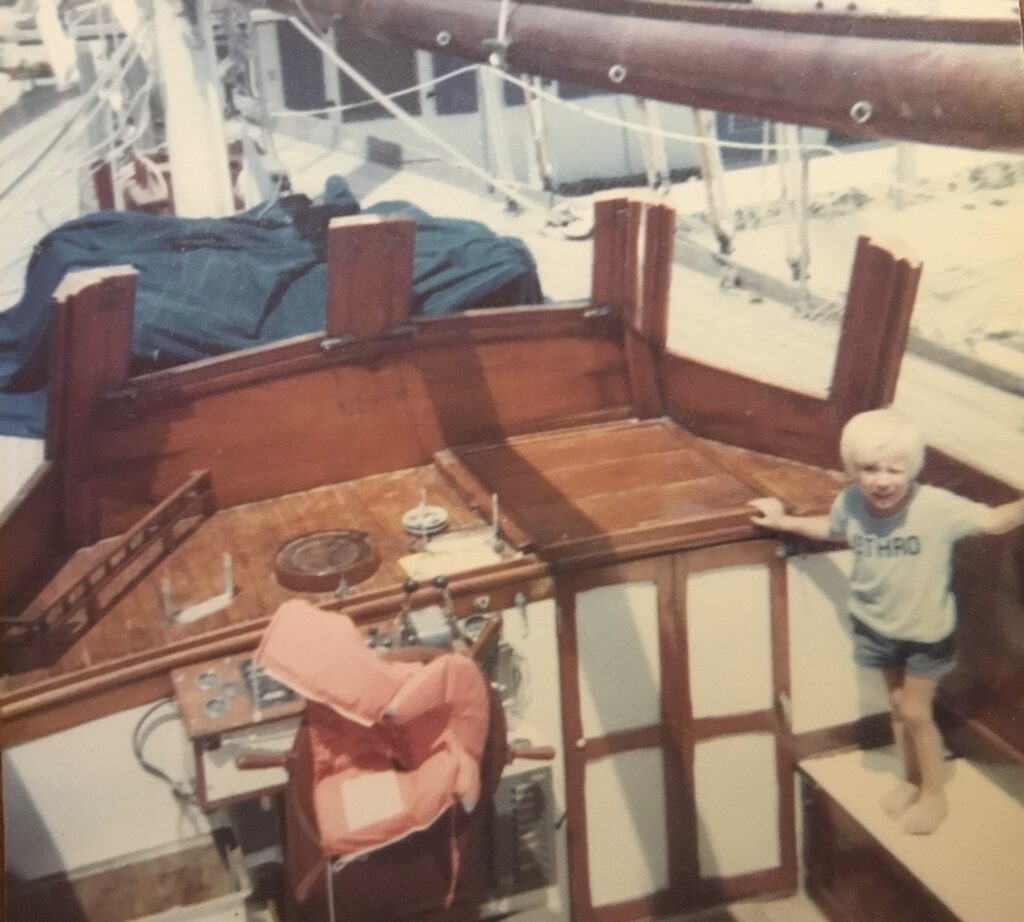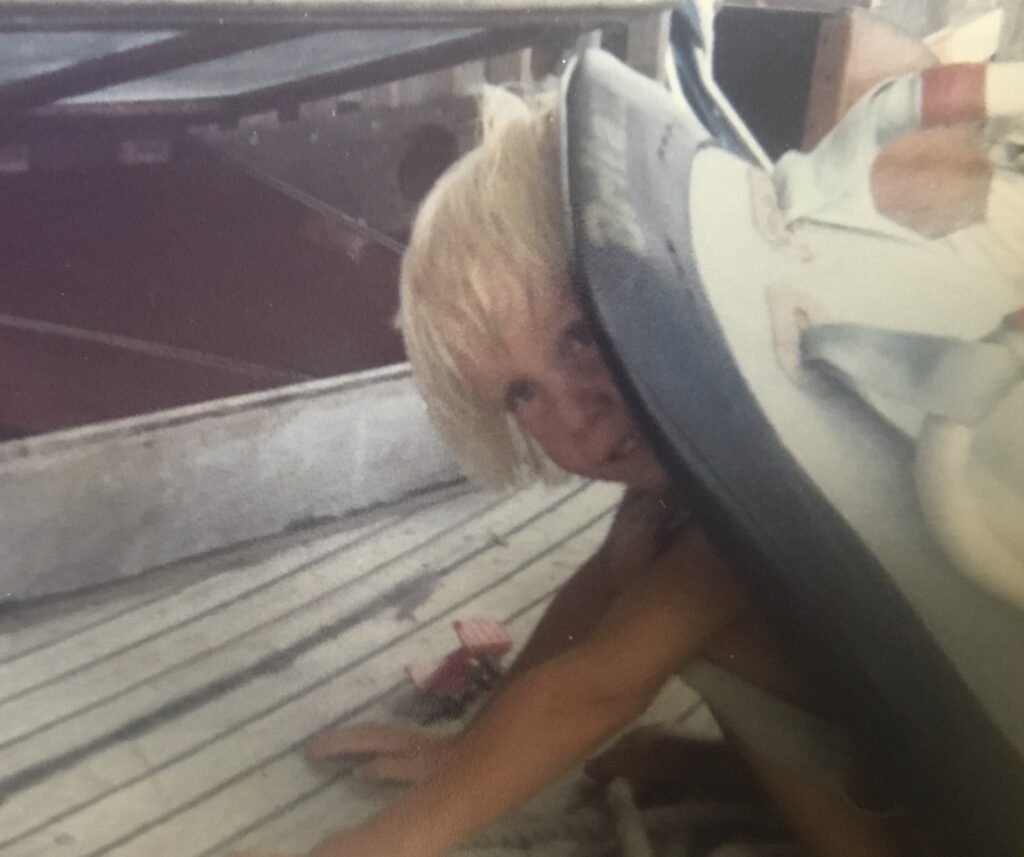Moving on board
The day we moved on board Camelot was spent removing much of the unwanted gear from all lockers. Jethro wanted to help so we set him up with a paintbrush and a bucket of water and asked him to ‘varnish’ the 28 inch propellor. That kept him busy for hours. In between times he made friends with everyone on adjoining boats. Our piles of timber, rusty old paint tins, lengths of hose, old fan belts grew. We separated useful from useless and used a yard trolly to take unwanted trash to the central waste collection pen. Fellow yard users found some of our junk worth recycling.
My first priority was to clean the galley. The oven seemed beyond redemption. I scoured the stainless steel sink and removed some obsolete plate racks, creating more usable space. Roger and Joy were attaching new copper sheathing to their hull on Tern IV. He told us about the Clarence Thomas hardware store where he had found self-tapping copper nails.
“You can buy household stuff there too,” he told me.
So I made a shopping list and set off to Passea with Jethro, who thought the propeller ‘varnish’ should be left to dry. We bought a cold box as the fridge space was beyond hope. I found essential kitchen utensils to replace the old rusty ones on board, as well as some melamine plates and bowls, sheets and pillowcases. We could then eat on board instead of having to buy meals ashore. Jethro and I stopped for an ice cream at the little shack by the ferry Terminal where taxi drivers waited in the shade.
When we returned Jon was in deep conversation with a Londoner who had built his own ferro cement 50 foot ketch called Endeavour, registered in the Isle of Man. He had even made all his own masts. He lived on board with his wife Maureen and young son Vernon. This was our first meeting with Malcolm McGee, who was to become a very helpful friend over the next few years.
“Call me Mack,” he said shaking hands with myself and Jethro. He had alarming news.
“Two years ago when I was hauled out here for anti fouling, Camelot was towed round from Prospect Reef. She had sunk on her mooring there!”
That explained the shocking condition of the engine and so much else. Especially if the engine had not been promptly rinsed with freshwater and checked over. On that first night we had a cold supper on the aft deck then Jon read Mister Tickle to Jethro as he settled him into the starboard berth in the saloon, whilst I washed up dishes in the galley only three feet away.
Sipping rum and tonic water on the comfortable seat behind the aft wheel on the poop deck we could enjoy the steel band music being played in the cafe area of the marina below. Lots of people were dancing. It was a beautiful night with the constellation of Orion overhead. I went below to check if Jethro was sleeping soundly and replenish our drinks.
Cockroaches
By the light of a paraffin brass lamp I was aware of loud ticking noises and gazed in horror. Dozens of brown cockroaches at least two inches long were running all over the galley and on Jethro’s bunk! I went up the companionway and called Jon to take a look. Although Jethro was snoring gently clutching his beloved Kermit frog toy, it was a shocking experience.
We would have to get the boat fumigated. Tortola Extermination came along with a truck the next day and ‘Bombed’ the interior after we had opened all the drawers and lockers. They came back two weeks later to repeat the performance because the dying act of the bugs was to lay more eggs.
On both days the truck was alongside delivering toxic chemicals I took Jethro off for several hours to discover more beaches. We went to Long Bay where the surf was too much for swimming but we could paddle and collect sea shells and fragments of coral. Next time we drove over the hills to the beautiful beach at Brewers Bay on the North side of Tortola where there were stone ruins of a sugar mill. I had to make Jethro wear a sun hat which he soon accepted as normal as well as lashings of sun protection.

We received a very reassuring letter from Jon’s father a few days later. He approved of the boat and suggested we must buy a new engine. The mechanic at Nanny Cay had just been deported so we asked around for suggestions. Ashton McCall came along to look. He was a middle aged Tortolan who was an expert on Perkins engines. He recommended a Perkins 4236 which would have to be imported from England.
Amongst the many items that came from the lock up in Prospect Reef were six sail bags containing the large gaff mainsail, the Bermudan mizzen and a furling Genoa, There was also a topsail, an unused storm jib and a self-tacking jib with a boom. Jon spread these out on some rough grass and found them to be in surprisingly good condition. The mainsail had two sets of reefing points. He managed to bend the main and mizzen onto Camelot after figuring out the rigging. He also made up some lazy jacks to help house the mainsail.
Jon decided the wheelhouse made Camelot too hot down below for this climate. It would have to go. Purchasing a new ripsaw he set about the task. The plan was to remove the roof and fixed windows and install a capping rail all round about 15 inches above deck level. Then we could have a Bimini cockpit shade that would fold down neatly when we were underway. The day he completed the neat sawing, there was a thunderous racket of a heavy man climbing the ladder howling in a very cut glass British voice:
“What the hell are you doing to my boat?”
Tony Snell
This was our first introduction to Tony Snell. The angry Englishman ranted on,
“I just had a survey done on Camelot a few weeks ago and was using the results to bargain the price down!”
Jon explained patiently that we had already paid for the boat and it was now our home. The Snell family ran a popular restaurant called The Last Resort at Trellis Bay, a tiny island near the airport. When he calmed down he accepted our offer of tea and sat down in the cockpit with the tell tail line of sawdust surrounding him. He told some rattling good yarns about his own experience of living with young children in that part of the world.
The yard crane came along later that day to lift the superstructure off. There was surprise from the crane driver that Jon knew how tie a bowline knot. He spent a few minutes teaching the driver who beamed with delight.
The bowsprit was indeed rotten, as Bill Mackay had told us. There was an American carpenter called Mike who lived at West End who could make us a new one if we could locate some Douglas fir. This Jon managed to do that at O’Neils yard. Having promised he could get onto it the very next weekend, Mike proved to be rather elusive as he was a keen surfer and the swell was up. We waited weeks.

At the end of March Jon tackled the dinghy. He replaced the rudder pintels and put in the dagger centreboard and the lateen-rigged mast. We decided to name her Guinevere, after King Arthur’s wife in the kingdom of Camelot.
Jon went out for a sail into the Francis Drake Channel whilst Jethro and I watched from the tiny pebbled beach near the entrance to Nanny Cay. I had made up a picnic. Jon sailed ashore to collect us. We had brought Jethro’s life jacket from home. Placing him in the bow seat, we had a lovely sail for about half an hour with me bailing constantly as there were leaks galore, then suddenly the mast snapped. Fortunately we had the oars and rowlocks on board.
A couple from Jersey came over to the boat one morning.
“Can you use this?” asked the blond lady. She was offering us a Britax child’s car seat .
“We have been living aboard for three years now and our daughter has grown out of it.”
I accepted gratefully. They came up the ladder to have a look around, then they helped us secure the seat to the rails on the poop deck next to our double seat behind the wheel. Jethro was delighted. He often asked to play with it and wore it on his back pretending to be a hermit crab.

Jethro became a hermit crab
In early April we had to go into the Immigration Office in Road Town to extend our permits. We were only allowed to stay in the British Virgin Islands for 30 days at a time. This involved an hour and a half wait in an air conditioned room queuing up with all the other non belongers who lived or worked on the islands. Then we paid $10 a head and were allowed to stay another 30 days. We were due to travel to South Africa for the Fireball World championships in May, so wanted to get Camelot re launched and leave her in a slip at Nanny Cay instead of out on the dirt.